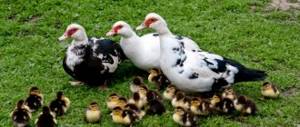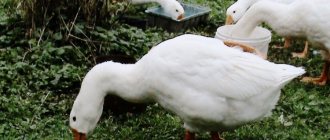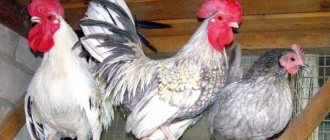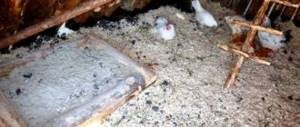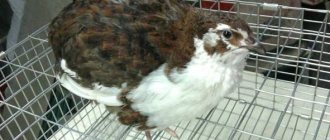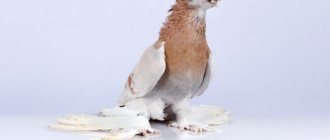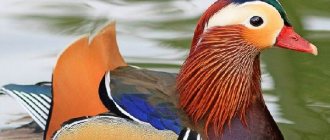The most interesting decorative breeds of chickens in a summer cottage
Many people are very mistaken about chickens, considering them birds to be stupid, ugly and incapable of emotions. But the owners of these birds will never agree with such an opinion and will be absolutely right. Currently, breeders have developed decorative breeds of chickens that completely refute the second of the three misconceptions. Although an ordinary motley hen is unusually beautiful.
Features of dwarf offspring
From the information above, you already understand that chicks are born not just small, but completely tiny. You can freely place 5-7 day old chicks on a human palm. The great tragedy is that babies are born weak, which is why some die.
Scientists say the problem has roots in chicken genetics. Experienced breeders recommend “marrying” individuals with paws of different lengths, because it is precisely because of this that squeaky babies die.
Little Japanese need special care - warmth, ideal cleanliness and special nutritional supplements increase the chances of survival of the chicks.
Babies are especially sensitive to temperature changes and high humidity, which can cause them to get sick and die. At the same time, the diet of children does not differ from the traditional one.
The best decorative breeds of chickens
It so happens that most decorative breeds of chickens come from the East and Southeast Asia.
Therefore, they often require special conditions of detention. Creating a better environment and familiar climate for them is a labor-intensive and costly process. But truly, it is worth it! When breeding ornamental breeds of chickens, you will have to strictly monitor the inheritance of breed characteristics. This group of poultry reaches sexual maturity much later than its meat and egg relatives. This happens mostly around nine months. Representatives of decorative eggs are also capable of laying eggs, but they are not particularly productive. It’s good if the chicken produces about 80 eggs per year.
There are decorative varieties that are grown exclusively for the purpose of chicken-loving. For example, there are dwarf chickens weighing only up to one kilogram, which lay no more than 90 small eggs per year.
Ayam Tsemani
An absolutely black Indonesian breed of chickens, the standards of which do not allow a single white spot in color. Breeders of this variety should cull individuals with even a tiny white mark on the tongue. Blood, meat, eyes – absolutely everything should be black.
Individuals of the Ayam Tsemani breed have difficult contact with humans due to their high fearfulness and anxious behavior, so their chicken coops must be located in a quiet place.
The breed is distinguished by aggressive behavior and a pugnacious character towards its own kind. Cockerels here grow to a maximum of 2 kg, chickens - 500 g less. Over the course of a year, a laying hen produces up to 100 large black eggs.
Phoenix
This long-tailed breed of chicken was bred in China, but it gained fame when it came to Japan. There is a belief that by placing the Phoenix in the south side of the yard, you can forever rid your family of misfortunes.
There are two breed branches - these are Japanese chickens (photo below), whose tail can reach 11 meters. And the German variety of Phoenixes, whose tail feathers can be up to 3.5 m long.
Today, acquiring the Japanese variety is almost impossible. But representatives of German Phoenixes are quite common.
The Phoenix chicken coop should be warm, as these birds do not tolerate cold weather well, during which the chickens' earrings and combs easily freeze.
Advantages of the breed:
- amazing decorative qualities;
- undemanding to food;
- delicious meat.
Flaws:
- low productivity (up to 100 small eggs);
- late puberty (about 2 years);
- the chicken does not hatch its offspring.
Decorative Phoenix roosters barely reach 2 kg of live weight, chickens do not grow up to 1.5 kg. Egg weight maximum 50 g.
Brahma
Brama are very beautiful giant chickens with amazing plumage.
The feet of birds of both sexes are beautifully covered with shaggy feathers. Brahma has a long beautiful neck, long legs and a short body with a compact tail. The standards do not allow: yellowish feather color, white tail, hairless legs, white metatarsals.
Representatives of the breed have an easy-going character. They are very affectionate and friendly, despite their huge size.
Brahma's meat is delicious, similar to turkey. Laying hens can lay up to 120 eggs per year. Sexual maturity occurs at 9 months.
Roosters can easily grow up to 5 kg, and hens - up to 4, and varieties of darker feather colors are much heavier than their lighter counterparts.
Padua
The Paduan is a breed that was bred a long time ago, back in ancient times. The first mention of these chickens with a lush crest around the entire head was in ancient Roman manuscripts and figurines dating back to the second century AD, so Italy is considered the country of origin.
These small ornamental chickens are not used for meat due to their small size: the weight of a rooster can be a maximum of 2.5 kg. A laying hen produces 120 eggs per year - this is a good indicator.
The Paduan diet must contain fruits and vegetables: carrots, apples, cabbage. The omnivorous nature of this breed can contribute to poisoning.
Paduans are known for their unusual nature for birds. They are incredibly friendly and sociable. They have good intelligence for chickens. They are very attached to their owner, they can eat from the hand and move on a person’s shoulder, like a pirate parrot.
Based on feather color and size, several subspecies of paduans are distinguished:
- white;
- black;
- gold;
- Shamoa;
- dwarf.
The latter have adult sizes not exceeding 0.9 kg.
Cochin
Dwarf ornamental Cochin chickens come from China. These chickens were kept at the imperial palace as decorative ones.
Distinctive features of the breed are the following qualities:
- voluminous, strong body;
- the plumage is rich, covering the entire bird completely, even the metatarsus;
- on the neck there is a mane of feathers, falling beautifully onto the shoulders;
- good-natured and sociable character, they love, like cats, to sit in the arms of the owner;
- the tail is short.
An excessively tall or narrowed body shape, a flat chest, a long tail, poorly pubescent or bare metatarsals and white lobes are unacceptable.
The thick plumage and edge of a low chicken always require clean bedding and a clean place for walking, so as not to contaminate the feathers and spoil the appearance of the bird.
Description of the Shabo breed
The appearance of chickens is surprising to those who see them for the first time. The first thing that catches your eye is the very short legs.
The dissonance between the length of the legs and the massive body makes one wonder: how do these chickens even move? Indeed, all dwarf chickens, including Shabo, lead a sedentary lifestyle.
Genetic short legs are a problem in miniature breeds. Their life expectancy is short. Shabots are the hardiest of all dwarf ornamental chickens . The standard dictates that short legs are essential for pure blood.
Decorative breeds of chickens. Description
- Breed Ayam Tsemani. Beautiful chickens. The unusual thing about these birds is that the plumage, comb, bones, meat, and sometimes blood are black . The weight of a bird reaches 1.5 kg, and a rooster – 2 kg. Individuals of this breed are characterized by long legs and a compact, narrow body. In a year, a hen bears 100 eggs, which can weigh more than 50 g.
- Araucan breed. The advantage of individuals is that they lay turquoise, blue and even green eggs . They are non-conflict, calm, and easily tolerate temperature changes. More than 170 eggs are hatched annually. The weight of a hen is 1.5-2 kg, and that of a rooster is 2-2.5 kg.
- The Bantamka Sittseva breed is the most numerous breed of chickens. It should be noted that roosters are characterized by an orientation towards leadership and pugnacity, and carefully protect their family. Another feature of birds is that they are able to hatch eggs several times a year . In this case, the weight of the hen is 0.5 kg, and that of the rooster is 0.9 kg. During the year, laying hens can lay more than 130 eggs, weighing 44 g.
- The Ga Dong Tao breed is the rarest breed of dwarf chickens in the world . Description: The birds are characterized by a wheatish hue, the crest is characterized by a nut-shaped shape, and the legs are very thick and scaly. The weight of the hen is 4.5-5.5 kg, and the rooster is 6-7 kg. Despite their significant mass, they move quickly. Birds hatch no more than 60 large eggs per year.
Gallery: decorative breeds of chickens (25 photos)
Chickens Shabo. Description
Japan is considered the birthplace of this bird. This breed is also called Japanese Bantam. Externally, these chickens differ significantly from other breeds - they are characterized by a down-to-earth body, small paws and wings that stretch along the ground. On the head there is a leaf-shaped ridge consisting of 4-5 teeth. The color of Shabot can be varied - red, porcelain, black, golden, wheaten. The weight of chickens often does not exceed 600-800 grams.
The male Shabot does not differ significantly from the female - he has a strong chest, is larger and has powerful wings for his size. Guns can be 200 grams heavier than chickens.
Character of Shabo chickens:
- Roosters take care of, protect, protect their females in every possible way , and pay attention to them. As a result of this, it is necessary that the chickens remain safe, since dwarf cockerels cannot always protect the family.
- This is a very friendly breed, so they always walk and eat together. Very rarely fights occur in such packs.
- Chickens are very brave, so they are not afraid to approach people or other animals.
- Chabots cannot be alone, therefore, having separated the bird from its family, it will suffer greatly.
Shabot chickens lay no more than 80 eggs per year, the size of which is no more than 30 grams. The shade of the shell varies depending on the color of the hen itself. Mother hens are constantly with their babies , protecting them, walking them and warming them with their wings. The chicks are so small that 5 chicks can easily fit in the palm of your hand. Due to the fact that they are very small, many simply die.
Features of keeping Shabo chickens:
- The chicken coop should be dry, clean, and the bedding should be changed frequently.
- To prevent birds from suffering from parasites, the litter should consist of a layer of sand.
- There should be a large area for walking. It can also be grown in a cage, but in this case the lifespan is reduced.
- The diet should contain vitamins, minerals, and calcium.
Millefleur chickens. Description
Millefleur chickens are the most famous breed of dwarf chickens. They have a neat body with dense plumage and have a variety of colors - black and white, porcelain, speckled blue, white, tricolor. The advantage of these birds is the presence of small “pants” , which give the chicken an attractive appearance. Despite their miniature size, they are very mobile and do not require a large area for maintenance. The weight of birds does not exceed 600-700 g, and roosters - 700-800 g. In a year, a hen can lay more than 100 eggs, the weight of which is 30 g.
Features of keeping Millefleur chickens:
- The chicken coop must have grass flooring.
- There should be no drafts or dampness
- The litter must be dry to prevent debris from sticking to the feathers.
- The chicken coop should have high perches.
- The diet should include root vegetables and fresh grass.
Malaysian Serama
The Malaysian Serama is the smallest breed of chicken, which was created by combining Japanese dwarf chickens with wild chickens of Malaysia. These birds are similar in size to pigeons, so the weight of a hen does not exceed 250-300 g, and that of roosters - 300-650 g.
Poultry conditions and care
Shabo are heat-loving chickens, so it is advisable to breed them only in regions with a temperate climate. In the middle zone, birds are placed in a heated chicken coop. The temperature inside should not fall below +16 degrees.
High humidity and stale air have a detrimental effect on the health of birds. The chicken coop should be equipped with a ventilation system to maintain a normal microclimate. A thick bedding made of a mixture of peat and sawdust is placed on the floor to preserve heat. It perfectly absorbs bird waste. To maintain cleanliness, you need to stir it once a week.
In the poultry house, perches of standard thickness are built - 4 cm at a height of 1–1.5 m. Shabots take off easily and it is not difficult for them to climb onto a perch. Drinkers and feeders are placed on the floor in an accessible place so that each bird can easily approach and get enough. You will need few nests - one is enough for 6-7 laying hens. The boxes are usually placed in a dark corner and covered with a layer of soft straw.
When breeding shabot chickens, poultry farmers are interested in increasing the productivity of laying hens. They produce only 80 eggs per year, some of which are not fertilized. Considering that the loss of young animals is 20–25%, you will have to fight for every egg. To increase the egg production of laying hens in autumn and winter, the chicken coop is illuminated with lamps. The light should be dim, dim. The recommended daylight hours are 13 hours.
Shabo chickens have a vulnerable immune system, so it is important to clean and disinfect the chicken coop more often. Fungal spores and bacteria that multiply in litter are deadly. It is recommended to wash drinking bowls and feeders every day, and then scald them with boiling water.
Walk
Despite their slowness, Shabot chickens love to walk in the fresh air. Walking strengthens their immunity and relieves boredom. In this regard, the birds will need an area covered on all sides with a net. It is advisable to equip the walking yard with a canopy to protect the birds from the rain.
In summer, Japanese bantams can walk for an unlimited amount of time if the weather is good. In winter, when the mercury is below zero, walking is prohibited. Chabots do not tolerate frost and can catch a cold, despite the presence of thick plumage.
Feeding recommendations
Ornamental Japanese bantams eat the same food as representatives of other chicken breeds, only they need less food due to their miniature size. The basis of the bird's diet is grain - whole, steamed and sprouted. Its share of the total volume is 50%.
In addition to grain crops, Shabo chickens are given:
- legumes;
- greenery;
- vegetables;
- dairy products;
- boiled fish.
The feed is enriched with mineral additives. Twice a week, bone meal and yeast are added to the mash. Birds should receive chalk and a small amount of salt every day. The source of calcium is crushed eggshells. A bowl of fine gravel is placed near the feeder, which helps the birds grind food in their crops. The drinking bowls should always contain clean water at room temperature.
Attention! During molting, which occurs in the fall and lasts 2 months, Shabot chickens are given vitamins. During this period, the body's protective functions decrease, and most of the resources are spent on the process of renewing the feather cover.
Tendency to diseases
Chickens of the Shabo breed suffer from colds more often than others. In this regard, breeders recommend keeping birds in a warm chicken coop, avoiding drafts and dampness. Walking of birds is limited in the cold season.
Japanese bantams often suffer from parasitic infections and tuberculosis. Keeping your coop clean will help prevent infestations from mites, chicken fleas, and bedbugs. To prevent tuberculosis, contact between domestic birds and wild birds should be limited. To do this, the walking yard is even covered with netting on top, and the floor of the chicken coop is poured with concrete to prevent rodents from getting inside.
Attention! Preventive vaccination will help protect livestock from deadly infections.
Dwarf chicken breeds
Hello, dear readers! Today we will present to your attention an interesting topic - dwarf chicken breeds; we will consider the smallest representatives of the chicken world. Photos and videos are attached.
Often, beginning poultry farmers refuse to breed miniature beauties, considering them to be purely decorative and not capable of good performance. But, in fact, these clogs are not only beautiful - they can be profitable and useful!
Let's look at the topic of dwarf chickens in more detail.
Breeding Shabo chickens
Sexual maturity in Shabo chickens occurs at six months of age. Laying hens have a developed brooding instinct, which greatly facilitates the breeding process. Since decorative breeds of chickens are subject to high requirements regarding compliance with the standard, individuals without defects are selected to form the parent flock. Chickens with the following defects are not allowed for breeding:
- narrow body;
- long back;
- legs that are too long or too short;
- poorly developed ridge;
- the color of the iris is gray or yellow-green;
- high-set or short wings.
Attention! Experienced poultry farmers advise choosing parents so that one of them has short legs, and the other is slightly longer than normal. It is believed that a short-legged pair produces weak and non-viable offspring
Care for the younger generation
Shabo chickens are born very tiny and need good care. To reduce the loss of young animals, you will have to place the chicks in a warm brooder and keep them there at a temperature of +28...+30 degrees for 3-4 weeks until they fledge.
In the first 2 days of life, chickens should be fed a boiled egg every 2 hours. Then steamed millet or corn grits and herbs are mixed into it. From the second week, low-fat cottage cheese, boiled fish, and grated carrots are gradually introduced into the diet. During this period, babies are transferred to four meals a day. Food is distributed at regular intervals.
The chicks' food is enriched with chalk and other mineral supplements. It is advisable to give vitamins to the younger generation, since young animals have very weak immunity. By the age of one month, chicks are fed in the same way as adult chickens.
Shabo chickens are an ideal option for those who do not have a large free area for keeping poultry and are interested in rare breeds. Miniature Japanese bantams are frequent visitors to exhibitions; they are bred not for meat and eggs, but for aesthetic pleasure and the sale of chickens. Before you start breeding an ornamental breed, you should weigh the pros and cons, because these birds require careful care.
- https://www.youtube.com/embed/5I3ljoyFb34
- https://www.youtube.com/embed/EFqYsJOYP_w
- https://www.youtube.com/embed/T-8IHFup0ks
- https://www.youtube.com/embed/EcJi4YM6VFA
Historical facts
Since ancient times, people have strived to improve their lives and everything that surrounds them. No one today can accurately answer the question of when the first chickens appeared. There are several theories regarding how this useful bird was domesticated.
Since then, poultry farming has developed in different countries, and people have learned to breed new hybrids. With the development of science, poultry farming has made great breakthroughs. Most of the new chickens existing today from various directions were created in the 18th-20th centuries.
The dwarf chicken breeds we are considering also began to appear en masse relatively recently.
What is known today is that over the previous 300 years, about 200 different new hybrids and breeds have been developed.
Features of care and maintenance of chickens of the Brama breed
keep separately from adults
Egg production in Brahma birds begins quite late, from about 8-9 months. Despite the fact that chickens of this breed are recognized as good hens and hatch their offspring, as a rule, to the end, it is still recommended to use chickens of other breeds for these purposes. This is explained by the fact that adults reach a weight of 3.5 kg and during breeding, some of the eggs can be crushed. It is best to attract a cross between Brahma chickens and a bird of some egg breed for this purpose. Such a hen retains all maternal instincts, however, her weight is 1.5-2 kg less.
Regardless of the purpose for which Brahma chickens are purchased (as a meat bird or an exhibition bird), it is necessary to provide them with certain food and living conditions.
The chicken coop should be equipped with drinkers, perches, nests and feeders. To maintain the purity of the breed, it is advisable to allocate a room separate from other birds, which should be sufficiently clean, dry and well ventilated. In order to increase egg production, the chicken coop is equipped with additional lighting.
It is better to make the floors concreted with necessarily dry litter, the layer of which in summer should be at least 6 cm, in winter - about 8-9 cm. The temperature in the chicken coop is monitored using thermometers.
Looking at the size of the representatives of this breed, it is not difficult to guess that they are not averse to eating well. Although Brahma chickens are not picky about food, however, to maintain a chic appearance and high productivity, it is necessary to provide them with a balanced diet, including fresh, high-quality feed, proteins, fats, carbohydrates and vitamins.
Brahma chickens should be fed according to a strictly established regimen. In the morning the birds are given a grain mixture, in the afternoon the chickens should receive a wet mash, and in the evening they should receive whole grain. To make the young animals more active and mobile, it is allowed to add another 15% of the feed to the grain.
The chicken coop should always have clean and fresh drinking water in sufficient quantities; in the cool season it is better to provide warm water. You should also regularly disinfect the premises, not forgetting about the drinking bowls.
Feeders are installed just above the chicken's chest, so that the feed does not spill past. It is more advisable to make drinking bowls at chest level. The chicken dining room must be equipped with a net, since there is a high probability that the rooster will certainly want to try the delicious lady food. The feeder for roosters is installed at head level.
You should not overfeed your birds, as excess weight can adversely affect their appearance and health. Therefore, it is better to switch your pets to low-calorie food or slightly reduce the food intake.
So, have you decided to become a farmer or should you just change your regular breed of chickens to Brahma? Then, before embarking on such an interesting activity, it is worth carefully studying the basic issues related to feeding, keeping and caring for Brahma chickens, so as not to be disappointed in the future.
Description of the Brahma chicken breed
Dwarf chicken breeds Top 5 best
Among the miniature representatives of the chicken world, there are popular and unpopular ones. Some are common throughout the planet, while others are exotic dwarf chicken breeds that are rare and quite expensive.
Below we will look at 5 representatives of this trend that poultry farmers love more than others.
Cochin dwarf chickens
Many farmers associate the name with the powerful Cochin Chough, which belongs to the meat category. But they also have small relatives who are bred for decorative purposes. A tiny copy of the Cochin appeared in China, and a very long time ago.
In those days when the first furry dwarfs appeared, only a few knew about them. This is not surprising, because the species was bred exclusively for the imperial court, and no one else had access to these little beauties.
Later, the emperor himself gave his wards as a gift to the ruler of Great Britain, and since then they began to gradually spread throughout Europe.
Best breeds
Decorative chickens are so diverse in their appearance that it is not always possible to understand at first glance that they are, in fact, chickens. Here is a description of the most beautiful and interesting breeds of this poultry.
- Chinese silk chicken. This bird resembles a soft ball of light fluff. The chickens owe this appearance to their plumage. Each feather is modified and resembles a fluff. Due to this feature, the plumage of Chinese silk chickens is used as filling for pillows and clothing. The beak, legs and even the skeleton of these birds are completely black.
The hens and roosters are small in size, so the breed is classified as dwarf.
- Araucana. This breed is also called Easter due to their fantastically colored eggs. It can be bright blue, turquoise and even emerald green. On the head of these birds there is an unusual lush plumage, as if the chicken had grown mustaches and sideburns. Some individuals may lack a tail. These birds differ not only in appearance, but also in their character. Roosters often fight over leadership, territory and mates.
The weight of an adult does not exceed two kilograms.
- Bantamka. Hens and chicks of this breed are very small. Bantams come in a wide variety of colors. You can find yellow, golden, silver and black and white birds. Females take good care of their offspring and lay up to 120 eggs per year.
- Ga Dong Tao. This breed is very rare, but is very interesting for breeders and lovers of decorative chickens. The most obvious difference between these birds is their legs. They are very thick, covered with scales. The comb is also fleshy and nut-like.
These chickens are very large. The rooster reaches seven kilograms, and the laying hen reaches five.
- Russian crested chicken. The decorative nature of this bird is manifested in its combed-back crest. Traditionally these chickens are white in color. A fairly calm breed that reproduces well. Laying hens have a developed maternal instinct and lay eggs well. Quite large birds, reaching 2-3 kilograms in weight.
- Pavlovskaya. These chickens resemble wild pheasants in color. The feathers are bluish-black at the base, and then continue with a silver or golden color. The plumage near the lower part of the beak forms a kind of beard. This breed tolerates cold and various diseases well.
Chickens are active, producing about 130-140 eggs per year.
- Malaysian Serama. Dwarf birds whose weight does not exceed 600 grams. This chicken is similar in size to a pigeon. The appearance of this bird is very unusual. The tail is directed perpendicular to the floor, the neck is arched. Laying hens produce very few eggs - up to 30 eggs per year.
Malaysian Serams are demanding in terms of living conditions, they love warmth and perfect care.
- Wyandotte. The breed is quite compact and cold-resistant. The weight of an adult reaches 3.5 kg. Chicks grow up to six months of age and can already lay eggs. Demanding on lighting: they love the sun.
- Russian kings. The progenitors of this breed are bantams. These dwarf birds were previously bred exclusively for decorative purposes, so that they would walk around the courtyard of nobles. The weight of an adult does not exceed a kilogram. Egg production is high - up to 140 eggs per year. The breed is distinguished by its good adaptability to unfavorable environmental conditions. Cold and disease are not very scary for Russian kinglets.
Chickens are excellent at hatching eggs, so they are sometimes given eggs from other breeds.
- Shaggy-legged chickens. Created through selection in Russia. A distinctive feature is the legs, covered with numerous thin feathers. There is a goatee and sideburns on the head. The color is not varied - it is golden beige. The weight of an adult reaches three kilograms. This breed produces quite a lot of eggs - up to 160 per year. The eggs are covered with a brown shell.
- Seabright. Another descendant of the bantam, which formed an independent breed. The most interesting thing about this chicken is the color of its plumage. The tail resembles a fan due to the special arrangement of feathers. Each feather is covered with a black edging, and the main color is brownish. Both hens and roosters have the same plumage color. Egg production is very low - about 50 eggs per year. But females can serve as mothers for litters of other breeds, as they have a well-developed maternal instinct.
Peculiarities
- Low, wide, down-to-earth body.
- Short back.
- Convex chest.
- Very short legs.
- There is lush plumage on the neck.
- The wings are long and touch the ground.
- The head is large, mostly painted in red tones.
- Large leaf-shaped comb. Teeth – from 4 to 5.
- The beak is strong and short. Its color matches the color of the plumage.
- Long straight tail.
- The tail feathers are carried high.
- Plumage of various tones: striped, black and silver, porcelain, black and gold, wheaten, yellow body and black tail.
The appearance of hens is in many ways similar to roosters. How to distinguish them:
- The head is smaller.
- The ridge is not so massive and often hangs to one side.
- There are no sharp braids in the tail.
Maternal instinct is highly developed. They carefully and carefully incubate the eggs and take care of the hatched chicks. This feature is used by poultry farmers.
Japanese Bantams are often “invited” to be hens on the eggs of other species of ornamental (and not only) birds.
History of Yokohama
Since the taming and domestication of chickens, humanity has accumulated extensive experience in their cultivation and breeding over 8 thousand years.
Many new breeds of chickens have been developed, and the qualities of those already known from ancient times have been improved. Hybrids appear. All breeds of chickens (no one has accurately counted them) are combined into several groups, depending on their use. With striking beauty and distinctive coloring, Yokohama chickens are a Japanese breed of ornamental chickens. True, the breed was perfected in Germany, where it was brought in the 1860s. These chickens were obtained by crossing two Japanese breeds - Minohiki and Onagadori.
The French missionary Jirad exported this breed from the port of Yokohama, which explains its name received in Europe. In 1864, chickens of this breed were presented at the Paris exhibition.
In Saxony, this breed was noticeably improved. Harrison Weir wrote about this in his Book of Poultry, published in 1902. He mentioned the creation of special clubs created for their cultivation and significant improvement.
There is a theory related to the fact that these chickens once became extinct in their historical homeland, that is, in Japan. And then reports were written confirming this fact. Japanese emperors kept chickens of this breed.
It is prohibited to export chickens outside of Japan, and their sale faces a significant fine.
Chickens of this breed were very popular in Great Britain. In the twentieth century they came to the United States of America. But they gained particular fame in Germany.
Climate and maintenance features
If you are planning to breed dwarf hens, it is important to take into account their heat-loving nature and inability to adapt to cold.
Feathered ladies are sensitive, like real aristocrats, and instantly react to any draft or high humidity. Given this feature, it is not recommended to keep them in harsh climatic conditions - in the north.
The rules for keeping Asian dwarfs are not very different from other breeds. Here are the most important nuances.
- A clean and dry chicken coop - warm bedding needs to be replaced in a timely manner.
- A layer of sand in the house is not a luxury, but a necessity if you do not want them to suffer from parasites.
- Possibility of free walking in a safe area during the warm season. Of course, there is the possibility of cellular maintenance, but in this case the viability is significantly reduced.
- They need supplements containing calcium, minerals and vitamins from the first days. It is especially important to feed laying hens during the brooding period.
Maturation and performance of the breed
As with other breeds, full maturation occurs at the age of 5-6 months. Chickens begin to lay eggs, and roosters become able to fertilize females.
The average egg production is 80 eggs per year, but in rare cases this figure can be 100-120 eggs.
Problems associated with egg production:
- The weight of the egg is only 28-30 g, which is almost two times less than that of ordinary laying hens.
- Rapid aging of cows. Already in the 3-4th year of life, productivity decreases significantly, so the chicken must be culled. Although the bird does not lose its attractive appearance, it is now impossible to use it to obtain high-quality eggs.
The weight of an adult chicken is 450-500 g, and a rooster is 550-700 g. The meat of the Shabot breed tastes more like partridge than chicken. It is tender, tasty, and also contains a small amount of fat.
Character of the breed
This is a social breed that does everything together. Its representatives are alien to internal contradictions, as well as fights for food or females. Roosters together take care of the satiety and safety of the chickens, driving away all uninvited guests.
In the event of an encroachment on its “wards”, the bird enters into a fight even with an enemy that is several times stronger in strength. For this reason, the owner should protect the “Japanese” from danger, otherwise the combative nature can lead to death.
It should be remembered that the cohesion of these chickens negatively affects relationships with other breeds. For this reason, the chabot should be kept in isolation, otherwise constant clashes cannot be avoided. However, the bird is not shy, so it is not afraid of people or pets.
Important! Individual individuals of the breed cannot be kept alone, in isolation from others, otherwise they will wither and die.
